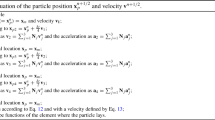Abstract
Heterogeneous incompressible fluid flows with jumps in the viscous properties are solved with the particle finite element method using continuous and discontinuous pressure fields. We show the importance of using discontinuous pressure fields to avoid errors in the incompressibility condition near the interface.
Similar content being viewed by others
References
Sommerfeld M, van Wachem B, Oliemans R (eds) (2007) ERCOFTAC Special Interest Group on Dispersed Turbulent Multi-Phase Flow, Best Practice Guidelines
Tezduyar TE (1999) CFD methods for three-dimensional computation of complex flow problems. J Wind Eng Ind Aerodyn 81: 97–116
Hughes TJR, Liu WK, Zimmermann TK (1981) Lagrangian– Eulerian finite element formulation for incompressible viscous flows. Comput Methods Appl Mech Eng 29: 239–349
Tezduyar TE, Behr M, Liou J (1992) A new strategy for finite element computations involving moving boundaries and interfaces. The deforming-spatial-domain/space-time procedure: I. The concept and preliminary numerical tests. Comput Methods Appl Mech Eng 94: 339–351
Tezduyar TE, Behr M, Mittal S, Liou J (1992) A new strategy for finite element computations involving moving boundaries and interfaces. The deforming-spatial-domain/space-time procedure: II. Computation of free-surface flows, two-liquid flows and flows with drifting cylinders. Comput Methods Appl Mech Eng 94: 353–371
Sethian JA (2001) Evolution, implementation, and application of level set and fast marching methods for advancing fronts. J Comput Phys 169: 503–555
Osher S, Fedkiw RP (2001) Level set methods: an overview and some recent results. J Comput Phys 169: 463–502
Guermond JL, Quartapelle L (2000) A projection FEM for variable density incompressible flows. J Comput Phys 165: 167–188
Tezduyar T, Aliabadi S, Behr M (1998) Enhanced-discretization interface-capturing technique (EDICT) for computation of unsteady flows with interfaces. Comput Methods Appl Mech Eng 155: 235–248
Tezduyar TE, Aliabadi S (2000) EDICT for 3D computation of two-fluid interfaces. Comput Methods Appl Mech Eng 190: 403–410
Idelsohn SR, Oñate E, Del Pin F (2004) The particle finite element method: a powerful tool to solve incompressible flows with free-surfaces and breaking waves. Int J Numer Methods Eng 61(7): 964–989
Oñate E, Idelsohn SR, del Pin F, Aubry R (2004) The particle finite element method: an overview. Int J Comput Methods 1(2): 267–307
Idelsohn SR, Oñate E, Del Pin F, Calvo N (2006) Fluid-structure interaction using the particle finite element method. Comput Methods Appl Mech Eng 195(17–18): 2100–2123
Idelsohn SR, Mier-Torrecilla M, Oñate E (2009) Multi-fluid flows with the particle finite element method. Comput Methods Appl Mech Eng 198: 2750–2767
Unverdi SO, Tryggvason G (1992) A front-tracking method for viscous, incompressible, multi-fluid flows. J Comput Phys 100: 25–37
Scardovelli R, Zaleski S (1999) Direct numerical simulation of free-surface and interfacial flow. Annu Rev Fluid Mech 31: 567–603
Smolianski A (2005) Finite-Element/Level-Set/Operator-Splitting (FELSOS) approach for computing two-fluid unsteady flows with free moving interfaces. Int J Numer Methods Fluids 48: 231–269
Li Z, Lubkin S (2001) Numerical analysis of interfacial two-dimensional Stokes flow with discontinuous viscosity and variable surface tension. Int J Numer Methods Fluids 37: 525–540
Minev PD, Chen T, Nandakumar K (2003) A finite element technique for multifluid incompressible flow using Eulerian grids. J Comput Phys 187: 255–273
Gross S, Reusken A (2007) An extended pressure finite element space for two-phase incompressible flows with surface tension. J Comput Phys 224: 40–58
Hyman JM (1984) Numerical methods for tracking interfaces. Phys D Nonlinear Phenom 12: 396–407
Floryan JM, Rasmussen H (1989) Numerical methods for viscous flows with moving boundaries. Appl Mech Rev 42: 323–337
Codina R, Blasco J (2000) Stabilized finite element method for the transient Navier–Stokes equations based on a pressure gradient projection. Comput Methods Appl Mech Eng 182: 277–300
Oñate E (2000) A stabilized finite element method for incompressible viscous flows using a finite increment calculus formulation. Comput Methods Appl Mech Eng 182: 355–370
Kang M, Fedkiw RP, Liu XD (2000) A boundary condition capturing method for multiphase incompressible flow. J Sci Comput 15: 323–360
Ganesan S, Matthies G, Tobiska L (2007) On spurious velocities in incompressible flow problem with interfaces. Comput Methods Appl Mech Eng 196: 1193–1202
Author information
Authors and Affiliations
Corresponding author
Additional information
S. R. Idelsohn is a ICREA Research Professor at CIMNE.
Rights and permissions
About this article
Cite this article
Idelsohn, S.R., Mier-Torrecilla, M., Nigro, N. et al. On the analysis of heterogeneous fluids with jumps in the viscosity using a discontinuous pressure field. Comput Mech 46, 115–124 (2010). https://doi.org/10.1007/s00466-009-0448-6
Received:
Accepted:
Published:
Issue Date:
DOI: https://doi.org/10.1007/s00466-009-0448-6




